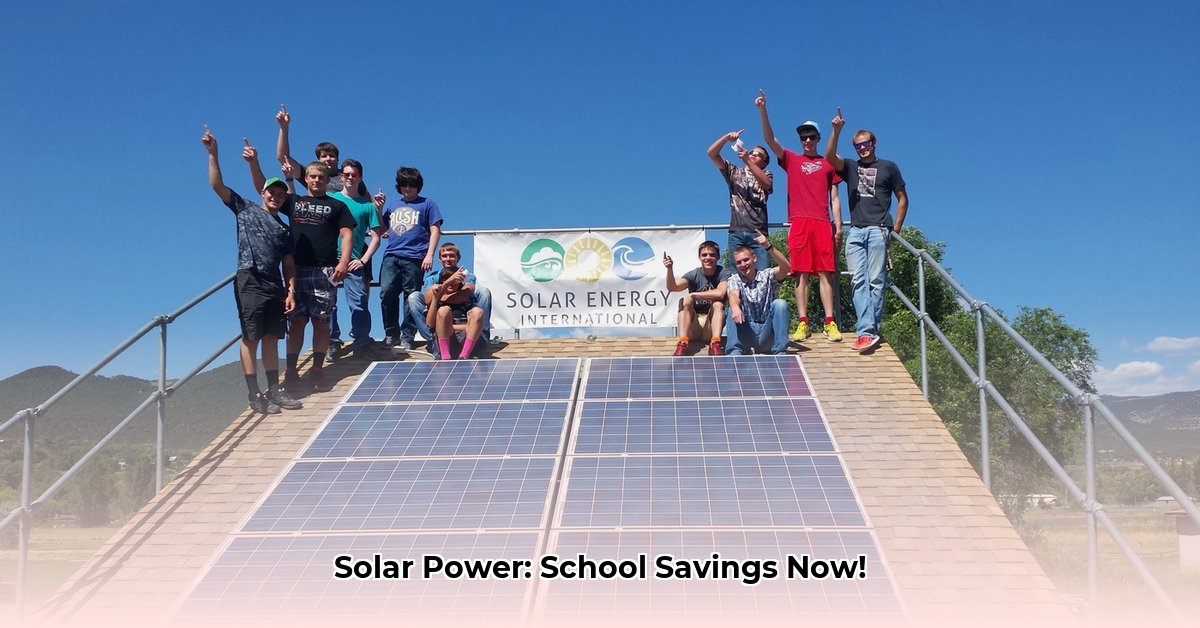Want to save money and teach kids about clean energy at the same time? Think solar power for your school! This comprehensive guide explores the advantages and disadvantages of installing solar panels on school buildings, offering insights into potential cost savings, enriched learning experiences, funding options, system maintenance, and community engagement strategies. It’s a complete resource to help schools embrace solar energy and cultivate a more sustainable future. For more on solar ROI, check out this helpful resource: Solar ROI insights.
Solar Energy in Schools: Lower Costs, Brighter Futures
Harnessing solar power to energize schools isn’t just a trend; it’s a strategic move that benefits students, educators, the community, and the planet. Let’s delve into why solar power represents a promising avenue for educational institutions seeking to reduce costs, improve educational resources, and minimize their environmental impact.
Saving Money with Solar Panels: The Financial Advantage
Schools often grapple with budget constraints, making energy costs a significant concern. Solar panels offer a viable solution to reduce these expenses and ensure energy efficiency. Studies indicate that schools can realize substantial savings, with some reporting reductions of up to 90%! These savings can be redirected toward vital classroom resources, updated technology, or improved teacher compensation. Many districts are exploring innovative financing options, such as partnerships with private companies or power purchase agreements, to mitigate the initial investment cost and facilitate a smoother transition. This translates to less upfront financial strain and greater budget predictability. The financial practicality of solar energy presents a win-win scenario for schools seeking to optimize their resources and minimize their impact.
Enhancing Education: Solar Power Upgrades STEM Learning
The advantages of solar energy extend beyond financial considerations. Integrating solar power provides unparalleled learning opportunities for students. Imagine students engaging in hands-on experiences with renewable energy technology, analyzing real-time data from solar panels, and participating in system maintenance. This practical approach facilitates the acquisition of valuable STEM (Science, Technology, Engineering, and Mathematics) skills, preparing the next generation for success in a rapidly evolving sustainable economy. Schools can leverage solar installations to enhance educational outcomes and inspire innovation among students.
Community Benefits: Shining a Light on Sustainability and Local Economy
The positive impact of solar energy in schools extends to the broader community. Solar panels prominently displayed on school roofs convey a powerful message of environmental responsibility, inspiring others to adopt sustainable practices and improve energy independence. Lower carbon emissions from the school contribute to cleaner air quality for everyone. In some instances, excess electricity generated by the solar panels can be fed back into the grid, further reducing reliance on fossil fuels. Moreover, the installation and maintenance of solar systems create local jobs, stimulating economic growth within the community. It becomes a symbol of collective action and environmental stewardship, fostering a sense of pride and unity among residents.
Addressing Challenges: Real-World Considerations for Solar Feasibility
While the benefits of solar energy are considerable, it’s crucial to acknowledge potential challenges associated with its implementation. One of the most significant hurdles is the upfront cost. While long-term savings are substantial, the initial investment can appear daunting to budget-conscious schools. Weather conditions also play a crucial role; solar panels generate less electricity on cloudy days. However, technological advancements, such as improved battery storage solutions, mitigate this concern. Additionally, some schools may face physical limitations, such as unsuitable roofs or insufficient space for panel placement. Careful planning and assessment are essential to overcome these challenges and determine the overall feasibility of solar energy projects.
Weighing the Pros and Cons: A Balanced Look at Solar Investment
Let’s examine the advantages and disadvantages of solar energy adoption:
Advantages:
- Substantial Cost Reduction: Significant savings on utility bills translate to more funding for core educational needs, such as textbooks, technology upgrades, and extracurricular activities.
- Enriched Learning: Provides practical, engaging lessons in STEM subjects, preparing students for future careers in renewable energy and sustainability.
- Community-wide Benefits: Improves air quality, stimulates local employment, and fosters environmental awareness, contributing to a healthier and more prosperous community.
- Environmental Leadership: Positions the school as an environmental leader, inspiring broader action among students, parents, and community members to adopt sustainable practices and reduce their environmental footprint.
Disadvantages:
- High Initial Expenses: The upfront cost requires careful planning and potentially securing external funding through grants, loans, or power purchase agreements.
- Weather Dependency: Solar energy production varies with sunlight availability, necessitating reliable backup power sources or energy storage solutions to ensure consistent electricity supply during cloudy days or nighttime hours.
- Technical Considerations: Suitability of the school’s roof, space constraints, and maintenance requirements need assessment to guarantee optimal system performance and longevity, potentially requiring structural modifications or ongoing maintenance expenses.
- Financing Complexity: Securing funding can be involved; careful investigation of grants and financing options is essential to determine the most financially viable approach for the school’s specific circumstances, requiring expertise in financial planning and renewable energy financing.
Solar Roadmap: Making Solar Energy a Reality
How can schools successfully implement solar energy? Here’s a step-by-step approach for renewable energy projects:
- Assessment is Key: Start with a thorough energy audit to determine energy consumption patterns and evaluate roof suitability for solar panel installation. Consider factors such as roof size, orientation, shading, and structural integrity.
- Explore Funding Sources: Investigate various funding avenues, including grants, loans, and Power Purchase Agreements (PPAs). Compare different options and choose the best fit for your school’s energy consumption and financial capabilities.
- Teamwork Makes the Dream Work: Involve all stakeholders—teachers, administrators, parents, and the broader community—in the planning and decision-making process. This collaborative approach ensures buy-in, addresses concerns, and fosters a sense of ownership among all participants.
- Integrating Education: Design a curriculum that incorporates solar energy into science, math, and technology lessons, providing a practical context for classroom learning and promoting environmental literacy among students.
- Continuous Monitoring and Evaluation: Track energy savings, educational outcomes, and the overall community impact. This data provides valuable insights and helps optimize the solar energy system’s performance and maximize its benefits over time.
Looking to a Brighter, Greener Tomorrow with Energy Solutions
Solar energy in schools is not a fleeting trend; it’s a forward-thinking strategy that benefits students, staff, communities, and the environment. With the cost of solar technology continuously decreasing and more innovative financing solutions becoming available, transitioning to solar power is becoming increasingly feasible for schools of all sizes and budgets. It’s an investment in a brighter, greener future – a future worth embracing with energy savings.
How to Secure Funding for School Solar Energy Projects
Key Takeaways:
- Solar power offers substantial long-term cost savings for schools, primarily through reduced electricity bills, freeing up resources for educational programs and facility improvements.
- Significant upfront investment is needed, but various federal and state incentives and grants significantly help offset initial costs and make solar projects more financially viable.
- The return on investment (ROI) is typically achieved within 5-10 years, making solar a sound long-term financial decision for schools seeking to reduce expenses and improve their bottom line.
- Several funding models exist (direct purchase, power purchase agreements (PPAs), and loans), each with its pros and cons. The best option depends on specific school circumstances and financial goals.
- Successful solar initiatives require careful planning, integration with school infrastructure, and teacher training to maximize educational impact and ensure long-term sustainability.
Understanding the Financial Landscape of Renewable Projects
Let’s be honest: schools are often strapped for cash. Energy bills are a significant expense. Solar power offers a potential solution, but it requires an initial investment. How to secure funding for school solar energy projects is the crucial question. Fortunately, several avenues exist.
Federal and State Incentives: A Lifeline for Solar Projects
The federal government offers programs like the Direct Pay program, significantly reducing upfront costs. However, state-level incentives vary widely in the renewable energy sector. Some states provide generous tax credits, rebates, and grants specifically for schools adopting renewable energy. Researching your state’s incentives is crucial. It’s like finding hidden treasure—a significant cost reduction waiting to be discovered.
Funding Models: Choosing the Right Fit for Implementation
Several financing options exist for school solar projects:
-
Direct Purchase: The school buys the system outright. This offers long-term ownership and potential tax benefits but requires a large upfront investment. Think of it like buying a house – a significant commitment upfront, but your own asset in the long run.
-
Power Purchase Agreements (PPAs): A third party finances, installs, and maintains the solar system. The school purchases the electricity generated, usually at a lower rate than traditional utility power. This is like renting—lower upfront costs, but you don’t own the system.
-
Loans: Schools can secure loans specifically for renewable energy projects, often with favorable interest rates and repayment terms. This is a bit like a car loan, spreading the cost over several years.
Choosing the right model depends on your school’s budget, risk tolerance, and long-term financial goals. Work with financial advisors and solar installers to determine the best option and navigate the solar market for the best deals.
Beyond the Dollars and Cents: The Educational Value of Solar
Don’t forget the educational benefits! A solar system can serve as a hands-on learning tool, teaching students about renewable energy, sustainability, and STEM concepts. This educational aspect is often overlooked, but it’s invaluable. It’s an investment in the future generation’s knowledge and future-proofing their skill set in green initiatives
- Hydro Extrusions USA Leads North American Aluminum Profile Solutions - December 28, 2025
- Hydro North America Leads Aluminum Extrusion Solutions Across Diverse Industries - December 27, 2025
- Hydro Extrusion North America Provides Custom Solutions Across Diverse - December 26, 2025
















